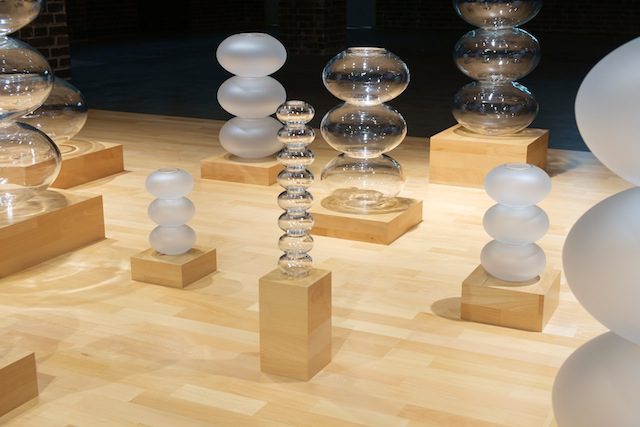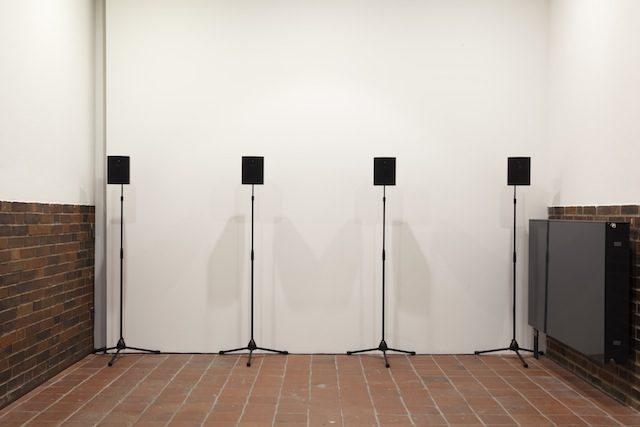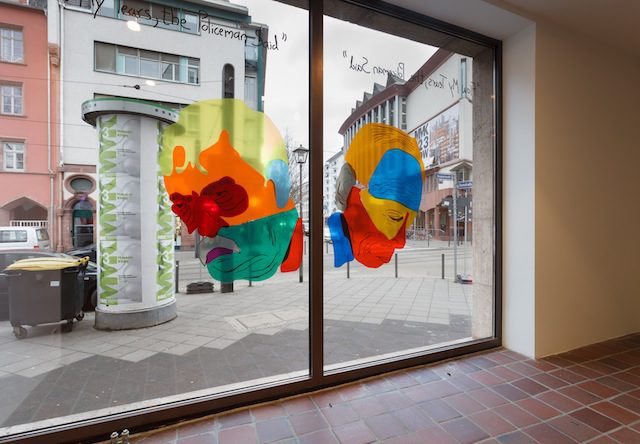Julia Haecker talked to Hassan Khan about his artistic approach and above all about the exhibition, which will be on view at the MMK 3 until 12 April 2015.

Hassan Khan, Abstract Music, 2015, Courtesy Hassan Khan. Photo: Axel Schneider
Flow My Tears, the Policeman Said at the MMK 3 of the MMK Museum für Moderne Kunst Frankfurt am Main is Hassan Khan’s first institutional solo exhibition in Germany. The title quotes that of a science-fiction novel of 1974 by Philip K. Dick. The exhibition does not want to retell the story but rather makes reference to its inherent themes. The close intertwinement between human complexity and power is one motif that can be encountered in the works on display. Julia Haecker talked to Hassan Khan about his artistic approach and above all about the exhibition, which will be on view at the MMK 3 until 12 April 2015.
Julie Haecker: Among others you work as a composer, author, director. Do you even think in categories like that? How would you describe yourself your own role?
Hassan Khan: Well I use the words musician, writer and artist rather than composer and author which might first sound like a small difference. But I think it says much about what I’m doing because the terms are wider. A composer is more related to a practice which is based on learning, skills and the craft of composing music in a certain tradition. But as a musician I work with the music itself and I can approach it in many different ways including more standard compositional tools. It’s the same with author. It’s a more restricted word related to the literally establishment. But a writer is a person who is just writing language. I think I have a relationship to all these various establishments but I don’t completely identify with them. That’s why I use these words that I feel are wider in their implications.
JH: The stunning variety and the quantity of your works point out that you seem to live in a continuous stream of thoughts. Is there a special way how you channel your ideas? Are there issues which you process in different ways?
HK: This is a good question. I think it has a lot to do with how I first began as a teenager – so a long time ago. I entered University when I was fifteen. University is for the most people a place where a lot of things happen. But when you are really young things are very powerful. It’s like an explosion of ‘things’. In this period I went through a phase of processing all what I could learn of what ‘humanity’ in general produces in terms of music, literature or painting or arts from all around the world and from all different times. It was all one big mix. I also started playing music at that time. I finished university when I was 19, 20 years old and at that time I already had a kind of intuition or a sense of what I’m doing. It didn’t have anything to do with mediums specifically. Each work demands a form which is specific to it. These ideas are not really interchangeable. And if there is a sort of translation then something important happens.
In 2006 for my exhibition Kompressor – I allowed myself for the first time to explore many different mediums and forms together. I found the synergy produced to be very interesting and productive. It was the first time that someone commented that this was a solo show that looked like a really good group show. I have heard similar comments quite a lot since. This moment is for me when forms are able to possess their own space and thus the ability to co-exist together. When that happens a real – a harmonious and dissonant – dialogue can take place. I’m very interested in exhibition formats that are able to produce this sort of dialogue and resonance.

Hassan Khan, Live Ammunition!, 2015, Courtesy Hassan Khan, Foto / photo: Axel Schneider
JH: Of course, to realize all this different kind of works you collaborate with a lot of other people, like actors, musicians, performers, theater directors. What’s your interest in this crossover? And to what extent to you let the participants realize their own ideas?
HK: It really depends on the work and varies quite a lot. For example I always begin working with actors by having a totally confidential conversation. None of what happen between us is revealed. In this process I try to deal with the actor not just as an actor but actually as someone who possesses the sum of total of human experience. In the process of the work we attempt find ways to re-access and to re-discover their own experiences and to understand that in a way that can be relevant to the performance we are developing. It is partially from their knowledge that I produce a performance, even if usually I have a structure and facets already in mind. This is just one example, there are many others.
Working with musicians is sometimes a bit similar. But again there are different approaches. In some pieces and with some musicians I go in like a composer. We work with session musicians, go to the studio and record these sessions. It’s a sort of normal situation for producing music.
But in other situations I work with musicians based on their understanding of their musical culture. For example I have a melody that comes from a genre they work in and I ask them to play this melody over and over again maybe without stopping, almost like a machine. This time the human factor has been mechanized. While he or she is playing I can start telling them to change this note or add this note.
And then when I’m happy with the melody we can record it but we also play it over and over again to drain it from the poses that are associated with the genre itself. The repetition simplifies the music and brings it to some primary structural patterns. In my piece Taraban for example I brought out a detail inside the melody which I then transform into a complete melody itself.
JH: Your works in the exhibition are in a very strong dialogue as you mentioned before. Most of the works in the exhibition are new productions. Did your ideas came up one after another or were the works supposed to show them together to produce this dialogue?
HK: At an early point I walked through the exhibition space with the curators Philippe and Klaus (Philippe Pirotte – director Staatliche Hochschule für Bildende Künste – Städelschule Frankfurt am Main – and Klaus Görner, curator at MMK Museum für Moderne Kunst – A/N) and I described the works and where they will be placed in one go. So the show was imagined in the space in like five minutes. But before that for a long time it was not clear what I will do and I also had deep reservations about the space itself. When there was no way out I found that I had to respond. That doesn’t mean that the works have just been worked out for this space. All of them had their own little histories. So for example the paravene (The Double Face of Power, 2015 – A/N) – for several years I have been trying to produce something that is not exactly like that but related to it, using car finish, the surface sheen, as a medium as a form of density and embedding things in that display. So this paravene is a continuation of another dialogue that I’m having with works which I want to produce. Some things are very calculated, other things are totally accidental. It’s a strange balance between both. But this is how I work a lot of times. I’m very very precise in some ways and in some ways I’m incredible messy. Mistakes become part of the works, almost because I could not deal with some of them. Not because I’m too lazy it’s almost more like the world has crashed and I cannot deal with that. A moment where I fear the mistake but am excited by it. I take risks then. I cannot explain it. In any case there is no one way to produce.
JH: The exhibition at MMK 3 is your first solo show in Germany. Was it difficult to choose respectively to produce a relatively small selection from your huge Oeuvre?
HK: Actually it’s not the first solo show in Germany, it’s the first institutional one, I already had an exhibition in a very small non-profit space in Berlin called Uqbar. But this is my first museum exhibition in Germany. I didn’t have a problem with showing a small selection. In the beginning Philippe said I didn’t have to produce new works, that I could also select older ones. The first thing I knew about the exhibition was that there is one older work – the film Studies for Structuralist Film no. 2 – which I wanted to show. Beside this I really wanted to produce new works. I had recently in 2012 and 2014 two big survey shows in Istanbul and Cairo. They were great experiences for me. ”

Hassan Khan, Studies for Structuralist Film no. 2 Silent Black and White HD Video, 23 minutes 42 seconds, 2013, Courtesy of the artist and Galerie Chantal Crousel
JH: Abstract Music is probably the most apparent work in the exhibition. With this work you try to materialize music by showing huge glass cylinders which don’t make any sounds. What’s the connection to music?
HK: Yes, the piece obviously has a connection to music. But my reference is not just music. My reference is primary abstraction which is about measurement, value and exchange. I think of the piece as a composition – it’s abstract music – because the system is based on regular identified units that are also different, they have different values. The way you do in a composition but it’s also what you might have in an economic system. There is a way of marking accumulation in this piece. For me accumulation is the moment in which a system comes into place. Without accumulation there is no excess, there is no possibility of exchange. I find that these paradigms are at the foundations of human ‘civilization’ – it’s really based upon primary gestures like that. Another primary is the basic fact of having a name. This piece is therefore for me a sublimation of a system that I feel is at the origins of a lot of what we have (as humans) produced together. And I say ‘civilisation’ not culture because I mean this in a really wide inclusive sense. There are some very distinct small tribal cultures that are different in this regard but the majority of humanity has lived under the same system of primary abstraction.
The film Studies for Structuralist Film no. 2, the piece Live Ammunition! – these are very concrete works while pieces like the paravene and the glass pieces deal with abstraction. These two things come together for me. We are materially present but we produce abstraction.
My aim is not for people to see the work and necessarily think of these ideas because these in the end are just ideas that I have thought of, nothing more than that. But there is something else that is valuable in having them which is that they allow the work to possess a density of meaning that is then open to the audience. This is then a process in which the audience could engage with the work by projecting their own emotional landscape onto it. Ideally that moment of engagement allows for something unknown to happen. Also for me I don’t this that this necessarily means that the audience is projecting ideas or interpreting something, but rather that an engagement and conversation with the ‘real’ might take place.

Hassan Khan, “Flow My Tears, The Policeman Said”, 2015, Courtesy Hassan Khan, Foto / photo: Axel Schneider
JH: In musical language abstract music means that music doesn’t follow any intention. So e.g. political or any other meanings are excluded from this idea of music. It just exist for its own sake. Did this work refers to the point that you prefer to exclude explicit political contents like many people suggest in your work?
HK: Actually it’s the opposite. First the piece Abstract Music is about a system. It’s about abstraction but abstraction is very systematic. And the piece itself is a system of thought. The work is constituted in a world in which politics is also constituted. It’s not about talking about politics but it’s made up out of the stuff which politics rules and is ruled by. Systems are a political thing. I do make a lot of arguments about the necessity of thinking of the work rather than having ready–made–interpretations whether they are political or cultural. For example if someone says that this work is against capitalism what else can the work ever tell then? By the way, while on the subject, I don’t think capitalism exists. I think no system actually really exists as such. These are just our messy descriptions of something that is partially there. But nothing is really total.
JH: Compared with your dense electronic compositions Live Ammunition! is a very reduced kind of music. You hear clapping hands producing a special rhythm. The piece was also produced before in certain ways. Why did you decide to produce another version? And is here a reason why you take this one for this exhibition?
HK: Live Ammunition exists in three forms. The very first was a composition in four movements for a live concert and titled Live Ammunition!! with two exclamation marks (not one) for strings, clapping and live electronics. The word ammunition is very loaded and in this case it’s directly connected with clapping as a collective percussive human activitiy. And then there was another iteration of the piece as one movement of Composition for a Public Park a three movement multi-channel music installation which premiered at the Nuit blanche Festival 2013 in Paris. The clapping in the different pieces is not all the same. Although they are all sourced from the same recording sessions I did with percussionists where I recorded different patterns that I had composed – I think there were 16 patterns in total. They are similar because the building blocks are the same but I’m configuring them in different ways. And that’s why the title Live Ammunition is sort of the same but changes slightly. Here it has one exclamation marks not two.
JH: Live Ammunition is directly connected to Flow my tears, the policemen said which is totally current since February 130 Egypts were sentenced to death at once by a judge who is illustrated on this work.
HK: Right now there are a lot of people doing little photoshop things. In the last weeks the judge became very popular, in a negative sense, as material for different kind of iterations on the internet. It’s a form of popular culture. Lot’s of people are just using this judge as material which is kind of what I’m doing too. It’s interesting that everybody is doing that by using basically the same aesthetic choice. Everybody has decided to portray him, the icon of authority, in a non- realistic fashion. It might be the intuited sense that if you represent this formal authority you need to desacralize it somehow and move it beyond a realistic rendition. A step has to be taken. That was a funny moment where I felt, and this is not my goal, that I was aligned with something happening in popular culture.
More Editorial